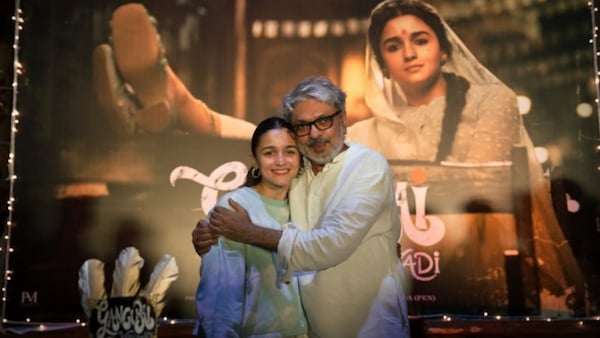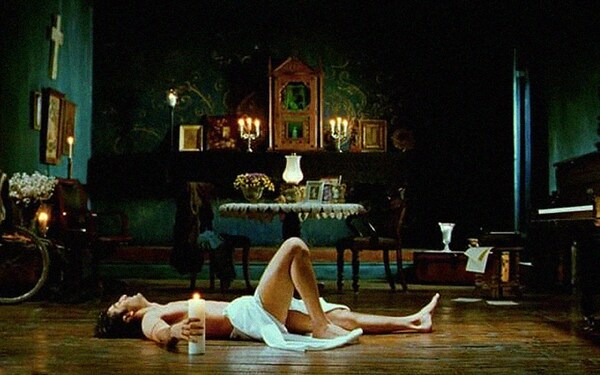The World According to Sanjay Leela Bhansali

- Prathyush Parasuraman
Film Companion
Last Updated: 05.48 PM, Sep 13, 2022

World building — the word implies something in flux, not completely built, because no world is completely built, always moving away from the past, moving into the future. Not with director Sanjay Leela Bhansali. His worlds are frozen in amber, girded by an unheeding, indulgent logic. There is an artifice here that he breathes life into with his full-blooded characters. When we see his films, we cannot but be aware of the labour in bringing a world into being. The sigh expressed, then, is both directed at that beauty and the imagined labour behind it.
Many of his collaborators have told me that he is most comfortable on a film set. He wanders around it like a ghost before people arrive, after people leave. When it is to be torn down, he mourns the loss of the world.
So dream-like and other-wordly, his movies have never had a dream sequence or a song that jettisons the narrative into another, alternative verse, because the one he roots his characters in, one which might be excessive to look at and exhausting to think of, is always enough.
I will substantiate and complicate this world building — or world built — using three instances from, three aspects of, his filmography.
The walls of Saawariya (2007) betray a world that has spun out of control. Urdu words, like ‘Jaan’ are calligraphed, with Mumtaz Mahal portraits and Lakshmi murals painted in shades from Monet’s palette. The colours are important. The Ganga-Jamuna tehzeeb is almost incidental, merely an aesthetic reprieve.


 Sheetal Iqbal Sharma, the costume designer of Gangubai Kathiawadi (2022), noted in an interview with Film Companion, how Bhansali sometimes changes the colour palette of an entire scene, redesigning the colour of doorways and walls keeping an outfit in mind. Alternatively, one of his characters — the fading beauty of Sheila Maasi (Seema Pahwa) — is always dressed to contrast the walls, so she could stand out among the younger, more beautiful women in the brothel. If the wall is pink, she will wear green. There is an immense attention given to a wall, its depth of colour, its capacity to contrast, its decoration.
Sheetal Iqbal Sharma, the costume designer of Gangubai Kathiawadi (2022), noted in an interview with Film Companion, how Bhansali sometimes changes the colour palette of an entire scene, redesigning the colour of doorways and walls keeping an outfit in mind. Alternatively, one of his characters — the fading beauty of Sheila Maasi (Seema Pahwa) — is always dressed to contrast the walls, so she could stand out among the younger, more beautiful women in the brothel. If the wall is pink, she will wear green. There is an immense attention given to a wall, its depth of colour, its capacity to contrast, its decoration.
 For the climax of Devdas (2002) — when the film was running out of time and money, with the producer in jail — Bhansali changed the colour scheme of the entire corridor that Paro (Aishwarya Rai Bachchan) runs through. It was supposed to be off-white, but overnight Bhansali insisted on making it sky blue with Ajanta-Ellora motifs, so Paro’s white sari with a red border could stand out. “Sanjay’s command over visuals is amazing. He pushed us to our extreme. Poor Aishwarya was running down that corridor for three days,” art director Nitin Chandrakant Desai told us.
For the climax of Devdas (2002) — when the film was running out of time and money, with the producer in jail — Bhansali changed the colour scheme of the entire corridor that Paro (Aishwarya Rai Bachchan) runs through. It was supposed to be off-white, but overnight Bhansali insisted on making it sky blue with Ajanta-Ellora motifs, so Paro’s white sari with a red border could stand out. “Sanjay’s command over visuals is amazing. He pushed us to our extreme. Poor Aishwarya was running down that corridor for three days,” art director Nitin Chandrakant Desai told us.
 But this command over visuals isn’t easy to explain to his collaborators, and thus execute. Bhansali isn’t chasing a specific colour, as much as he is chasing a specific feeling. His briefs are, thus, vague and poetic, impressionistic and impossible to distill. While deciding on the colour of Kashibai’s room in Bajirao Mastani (2015), Bhansali had told the cinematographer Sudeep Chatterjee, “I want something that makes me want to take off my shoes and sit on the ground.” “I’ll never forget that brief,” Chatterjee said later.
But this command over visuals isn’t easy to explain to his collaborators, and thus execute. Bhansali isn’t chasing a specific colour, as much as he is chasing a specific feeling. His briefs are, thus, vague and poetic, impressionistic and impossible to distill. While deciding on the colour of Kashibai’s room in Bajirao Mastani (2015), Bhansali had told the cinematographer Sudeep Chatterjee, “I want something that makes me want to take off my shoes and sit on the ground.” “I’ll never forget that brief,” Chatterjee said later.
Bhansali’s fixation with top shots — a perfectly symmetrical viewfinder as fabrics flare or a myriad banana leaves open in a simultaneous rustle beneath — is known. In interviews, he refers to it, pretentiously, as the view of God. Rarely, however, has he used the top shot to express space. In historicals, there is this desire to sweep the camera over CGI cities of the imperium, to show scale, to show technology. Not Bhansali.
 The one time that Bhansali showed an entire city was the very first shot of Saawariya. Rani Mukherji, the narrator of the film, in her sultry voice introduces the world, “Khwabon ka yeh shehar duniya ki kisi nakshe mein nahin milega aapko yeh, kyonki yeh sirf mere khayalon mein hai.” (This city of dreams, you won’t find in any map, for it exists only in my thoughts.)
The one time that Bhansali showed an entire city was the very first shot of Saawariya. Rani Mukherji, the narrator of the film, in her sultry voice introduces the world, “Khwabon ka yeh shehar duniya ki kisi nakshe mein nahin milega aapko yeh, kyonki yeh sirf mere khayalon mein hai.” (This city of dreams, you won’t find in any map, for it exists only in my thoughts.)
The image is a painting of a city, tinted blue, seen from a height. In the foreground is Buddha and the turret of a mosque. Below is a city of bridges and waterways, Turkish domes and British roofs, and a big, creamy moon.
 When people, rather simplistically, say that Bhansali’s frames are like a painting, they mean that it possesses an attention to detail, as though he is literally carving every inch of a frame into existence through labour and artistry. In this case, he actually used a painting, a CGI train spewing smoke across this city. He had no intention of realism, perfectly fine with artifice, perfectly confident that this artifice won’t translate into doubt or distance. That these are worlds — worlds we know don’t exist — we will still yearn for.
When people, rather simplistically, say that Bhansali’s frames are like a painting, they mean that it possesses an attention to detail, as though he is literally carving every inch of a frame into existence through labour and artistry. In this case, he actually used a painting, a CGI train spewing smoke across this city. He had no intention of realism, perfectly fine with artifice, perfectly confident that this artifice won’t translate into doubt or distance. That these are worlds — worlds we know don’t exist — we will still yearn for.
Despite being set in this geographic netherworld, somewhere tucked in Gujarat, in Goliyon Ki Rasleela Ram-Leela (2013), the phone plays an important role. Lovers speak with phones glued to their ears, the villains conspire to kidnap over the phone, and the thirsting woman excitedly photograph an oiled, bare-chested Ram (Ranveer Singh) using their phone’s camera. The ringtone is a comic reprieve. Sexting is a thriving language of lovers. In many of Bhansali’s previous films, he has often used the phone booth or letters as means of communication. The urgency of letters have been replaced by the immediacy of phones.
The phone — a piece of technology that anachronistically places the film in the contemporary moment — is suddenly thrown into important scenes. After an intense exchange of words, Ram requests Leela for a photo, and gives instructions to his minions. That this photo of the two of them must go on Twitter and then, the newspaper.
 The thing about technology is that it signals flux. That information streams in, changing your relationship to the world through trickles of knowledge. But that is not at all what is happening here — a world where Ahmedabad and Uttarakhand are mentioned to remind us that even with the palatial mansions, dusted with paintings of Raja Ravi Varma and cooing peacocks, it is not a consummate world. This is Bhansali comfortable with the idea that his universe, a tender, torturously-conceived universe, has its horizons, its limits, and thus, isn’t endless. That even as it doesn’t have much of an impression on his world, a world beyond his world exists.
The thing about technology is that it signals flux. That information streams in, changing your relationship to the world through trickles of knowledge. But that is not at all what is happening here — a world where Ahmedabad and Uttarakhand are mentioned to remind us that even with the palatial mansions, dusted with paintings of Raja Ravi Varma and cooing peacocks, it is not a consummate world. This is Bhansali comfortable with the idea that his universe, a tender, torturously-conceived universe, has its horizons, its limits, and thus, isn’t endless. That even as it doesn’t have much of an impression on his world, a world beyond his world exists.

 Premium
Premium